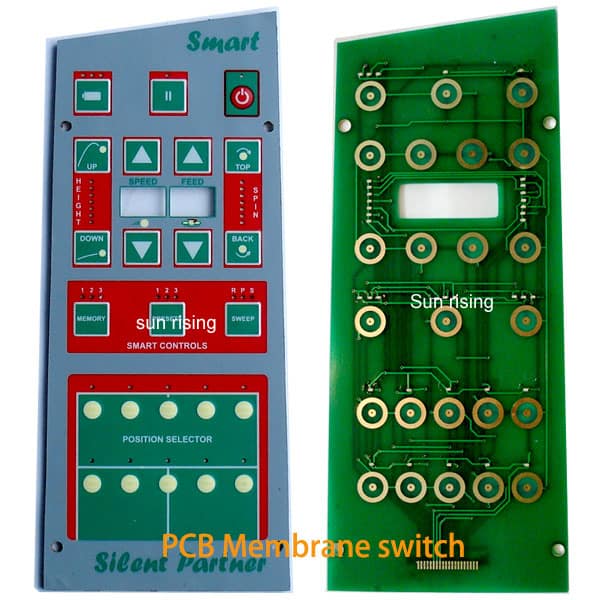Why Membrane Switches Are Important for Resilient Control Systems
Membrane buttons play a crucial duty in making sure the toughness and dependability of control systems across various sectors. Their distinct construction allows them to sustain difficult environmental factors such as moisture, temperature extremes, and physical wear. This resilience not only extends the life-span of the systems they serve but additionally lessens maintenance demands. As we check out the multifaceted benefits of membrane buttons, it ends up being apparent that their value goes beyond mere capability, influencing user experience and functional efficiency. What additional implications do these features hold for the future of control system style?
Introduction of Membrane Layer Switches
Membrane layer switches are versatile and trustworthy parts commonly utilized in different digital control systems. These buttons are composed of numerous layers, including a graphic overlay, a spacer layer, and a printed circuit layer. The visuals overlay gives both useful and visual design, while the spacer layer guarantees that the switches are triggered only when pressed. The printed circuit layer consists of conductive traces that finish an electric circuit when the membrane layer is pressed, enabling the device to react to user inputs.
Membrane switches are typically preferred in applications needing a small and lightweight design, making them ideal for portable tools, medical tools, and commercial machinery. They can be customized to satisfy certain individual requirements and can incorporate numerous functions such as backlighting, tactile feedback, and numerous shades. Moreover, membrane buttons are resistant to dirt, wetness, and pollutants, making them suitable for settings where toughness is necessary.
Benefits of Sturdiness
In many applications, the longevity of membrane switches deals substantial benefits that boost their general efficiency and dependability. These buttons are developed to hold up against harsh atmospheres, making them perfect for usage popular problems such as high humidity, severe temperature levels, and exposure to chemicals. Their durable construction assists to stop damages from physical influence, guaranteeing durable capability and decreasing the need for regular substitutes.
Additionally, membrane layer buttons are resistant to damage, which is crucial in applications where regular communication occurs. This sturdiness converts to lower upkeep expenses, as companies gain from lowered downtime and less service disturbances. Additionally, the encapsulated design of membrane changes shields inner components from dust and wetness access, more adding to their lifespan.
An additional benefit is their capacity to keep consistent efficiency over time. With a high tolerance for mechanical tension, these switches preserve their tactile feedback and electrical integrity, guaranteeing user fulfillment. Eventually, the toughness of membrane layer changes not only enhances operational efficiency yet additionally cultivates self-confidence in their dependability, making them a favored choice for control systems across numerous fields.
Applications in Numerous Industries
Resilient control systems utilizing membrane switches locate considerable applications throughout a variety of industries, each taking advantage of the one-of-a-kind features these switches provide. In the medical field, membrane layer switches are critical for tools such as individual screens and analysis devices, where reliability and ease of cleansing are critical. Their resistance to moisture and pollutants ensures they keep performance in clean and sterile atmospheres.
The automobile sector leverages membrane buttons for dashboard controls and infomercial systems, where they supply sleek, inconspicuous interfaces that boost user experience. These buttons are also made to endure rough conditions, consisting of exposure to severe temperatures and resonances.
In commercial setups, membrane layer switches are generally used in equipment control panels, using tactile comments and longevity required for high-usage applications. Their capacity to resist chemicals makes them appropriate for making settings where spills and contaminants are regular.

Customer electronic devices, such as cooking area appliances and push-button controls, additionally make use of membrane layer switches for their flexibility and cost-effectiveness. In general, the flexibility and durable nature of membrane switches make them important throughout numerous fields, ensuring efficient operation and longevity in control systems.
Style and Aesthetic Charm
While capability is extremely important, the layout and visual allure of control systems equipped with membrane switches play an essential role in user engagement and overall experience (membrane switch). The visual style of these switches can considerably influence user perception and communication. A properly designed membrane layer button improves the appearance of the gadget, making it much more appealing to users and cultivating a link in between the individual and the product
Membrane switches over supply a wonderful bargain of versatility in style, allowing manufacturers to tailor graphics, shades, and appearances to straighten with brand name identity and product visual appeals. Making use of vivid shades and click for info distinctive patterns can attract interest, while tactile feedback can enhance the individual's communication with the gadget. In addition, the capacity to integrate LED signs and backlighting right into the membrane layer button design supplies both useful and visual benefits, boosting exposure and usability in numerous environments.

Enhancing Individual Experience

Moreover, membrane switches can be customized to incorporate graphical interfaces, enhancing usability by presenting information in a clear and user-friendly way (membrane switch). This personalization can include icons, labels, and color coding that guide users through facility functionalities with ease. Additionally, their versatility permits integration in numerous settings, making certain regular efficiency whether in industrial equipment or customer electronic devices
The longevity of membrane layer blog buttons likewise plays a vital role in user experience. By withstanding rough problems and prolonged use, these buttons minimize the possibility of system failures, thus advertising dependability and user self-confidence. Inevitably, the tactical use of membrane layer changes not only boosts performance but additionally substantially enriches customer communication with control systems, making them a vital part in modern-day design.
Final Thought
